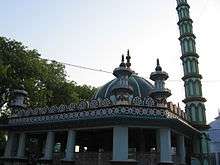Makhdoom Sharfuddin Ahmed Yahya Maneri
| Makhdoom Sheikh Sharfuddin Ahmed bin Yahya Maneri | |
|---|---|
 A picture of Badi Dargah | |
| Born |
July 1263 A.D. (29 Sha'aban 661 A.H.) Maner, Bihar |
| Died | January 1381 A.D.(6 Shawwal 782 Hijri) |
| Resting place |
Badi Dargah, Bihar sharif, Bihar Dargah 25°10′49″N 85°31′10″E / 25.18028°N 85.51944°E[1] |
| Known for | Sufi Saint |
| Home town | Maner, Bihar |
Makhdoom Sharfuddin Ahmed bin Yahya Maneri popularly known as Makhdoom-ul-Mulk Bihari[2] and Makhdoom-e-Jahan [3] is one of the most prominent Sufi saints of Bihar & India.
Biography
Sheikh Sharfuddin Ahmed, born on July 1263 A.D. (Sha'aban 661 A.H.) at Maner, a village near Patna in Bihar, was the son of Makhdoom Kamaluddin Yahya Maneri bin Israel bin Taj Faqeeh from Al-Khaleel (Palestine). His father Makhdoom Yahya Maneri was also a great Sufi saint of Maner in Patna district.
His maternal grandfather Shahabuddin Jagjot Balkhi was also a revered Sufi, whose tomb is located at Kachchi Dargah near Fatuha in Patna district.
At the age of 12, He left Maner to gain traditional knowledge of Arabic, Persian, logic, philosophy and religion under Ashraf-Uddin Abu Towama Bukhari (a famous scholar) in Sonargaon near Narainganj (now in Dhaka, Bangladesh) where he spent 24 years in his company.
At first he refused to marry, but when being ill, he was advised by the physician to take to marriage as the remedy for his disease. He married Bibi Badaam. He left home after the birth of a son, named Zakiuddin in 1289 A.D. who lived and died in Bengal.[4]
After completing his education he left for Delhi where he met with Hazrat Nizamuddin and a number of other Sufis. His elder brother Makhdoom Jaleeluddin Maneri (Buried at Badi Dargah in Maner Sharif), who accompanied him there, finally introduced him to his own peer (spiritual master) Sheikh Najeebuddin Firdausi and he became a disciple of Sheikh Najeebuddin Firdausi of Mehrauli and got the title of Firdausi.
To shun material comforts, Sheikh Sharfuddin Ahmed bin Yahya Maneri went into the forest of Bihiya (about 15 miles west of Maner). He later went to Rajgir (about 75 miles east of Maner) where he chose to do ascetic exercises in the hills. A hot spring close to a place where he often prayed in Rajgir, is named Makhdoom Kund, to perpetuate his memory.
At least 30 years in the forests, Sheikh Sharfuddin Ahmed bin Yahya Maneri finally settled at Bihar Sharif. Later Sultan Muhammad Tughlaq built a Khanqah for him where he taught and trained disciples in Sufism (Tasawwuf). He devoted his entire life to teaching and writing.
Bibliography
The collection of his letters (Maktoobat) and sermons (Malfoozat) had received wide acclaim. His maktoobat is regarded as a ‘working manual’ amongst the highest in Sufi circles.[5]
- Maktubat-i-Sadi, a 'Series of a Hundred Letters' (or rather essays on definite subjects) addressed to his disciple Qazi Shamsuddîn in 747 Hijra.
- Maktubat-i-Bist-o-hasht, a 'Series of 28 Letters', being replies to the correspondence of his senior disciple, Muzaffar, the prince of Balkh.
- Fawaed-i-Ruknî, a number of brief Notes prepared for the use of his disciple Rukn-ud-dîn.
His Successors
- Qazi Shamsuddin
- Maulana Muzaffar Balkhi
- Sheikh Rukn-ud-din
- Sheikh Zain-ul-Badr Arabi
Death
He died on Thursday, January 1381 A.D. (6 Shawwal, 782 Hijri).
The funeral prayer was said according to his will. His will decreed that his funeral prayer be lead by a sufi from Semnan, a princely state in Iran, who was on his way to Pandua in Malda district of West Bengal to pledge spiritual allegiance on the hands of the renowned sufi Alaul Haq Pandavi and enter into the Chishti spiritual order. Accordingly, no sooner that his funeral was prepared Syed Ashraf Jahangir Semnani reached Maner Sharif and lead the funeral prayers.[6]
His Tomb lies at Badi Dargah (Bihar Sharif Nalanda), in a mosque to the east of a large tank, with masonry walls and ghats, and pillared porticos. The tomb is situated in an enclosure half filled with graves and ancient tress, on the north and west of which are three domed mosque and some quaint little cloisters. His tomb at Bihar Sharif is still resorted to as a place of sanctity by a large number of devout Muslims and a five day Urs is celebrated every year from 5th Shawwal with traditional zeal at Bihar Sharif.
References
- ↑ "Tomb Of Shaikh Sharfuddin Ahmed Yahya Maneri Baridargah - Wikimapia".
- ↑ "Makhdum Shaikh Sharafuddin Yahya Maneri ~ Spiritual World".
- ↑ "Urs of Yehya Maneri begins - Times of India".
- ↑ zubaid, syed mohammad. "books".
- ↑ "Salaam Knowledge".
- ↑ Hayate Makhdoom Syed Ashraf Jahangir Semnani(1975),https://www.rekhta.org/ebooks/hayat-e-syed-ashraf-jahangir-samnani-syed-waheed-ashraf-kichhauchhvi-ebooks Second Ed.(2017) ISBN 978-93-85295-54-6, by Syed Waheed Ashraf, Maktaba Jamia Ltd, Shamshad Market, Aligarh 202002, India,